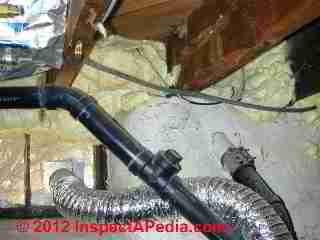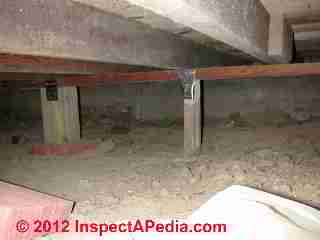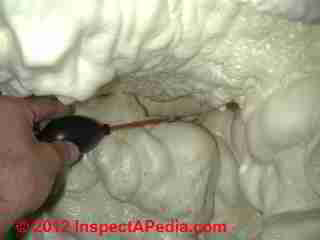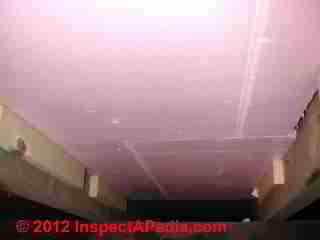 Crawl Space Insulation Retrofit - Spray Foam
Crawl Space Insulation Retrofit - Spray Foam
- POST a QUESTION or COMMENT about adding crawlspace insulation using foam
Crawl space insulation improvements - retroffitng insulation into the crawl area:
This article describes several alternative processes for adding crawl space insulation and the use of spray foam insulation in crawl areas. We include photos that compare spray foam insulation with cut-and-paste foam board insulation.
Our page top photo shows why you would want to remove old fiberglass insulation, then clean, and properly insulate an existing crawl area, but the advice below pertains to new construction as well.
InspectAPedia tolerates no conflicts of interest. We have no relationship with advertisers, products, or services discussed at this website.
Crawl Area Insulation Retrofits - OK to use Spray Foam
A variety of foam building insulation products are marketed for insulating crawl areas, as we review here.
Using Polyurethane Foam or Icynene® Insulation for Crawl Space Insulation Retrofits
at ICYNENE FOAM SPRAY INSULATION we discussed the properties of Icynene® foam insulation (and similar products).
This foam is a spray-in-place product, injected through openings, or pour-in expanding-foam insulation product. Other water borne foam spray insulation products, including some latex-foams, are available.
Our photo illustrates the author testing for air leaks at an apparent void in foam insulation sprayed in a tight crawl space.
Where access is very restricted it can be difficult to spray any foam in a smooth, uniform, and airtight pattern.
Our next photo (below) illustrates a mixed-media insulation retrofit in a crawl area.
At URETHANE FOAM Deterioration, Outgassing we discussed some historic concerns surrounding polyurethane foam insulation, including the water resistance of open-celled spray foams, outgassing, and insect resistance.
 But there are modern spray polyurethane products that are closed-cell insulation suitable for use in damp locations and that may perform well in a crawl space, avoiding the issues we discussed above as well as the issue of mold formation in fiberglass insulation.
But there are modern spray polyurethane products that are closed-cell insulation suitable for use in damp locations and that may perform well in a crawl space, avoiding the issues we discussed above as well as the issue of mold formation in fiberglass insulation.
See MOLD in FIBERGLASS INSULATION
and MOLD in FOAM INSULATION for details about mold problems in building insulation.
See HOW TO DISTINGUISH AMONBG UFFI, Icynene, and Latex Foam Insulations for more detail on the identification of these individual foam insulation products in the field
Here is what the U.S. Department of Energy says about polyurethane insulation in buildings - (the US DOE comments are consistent with our text above):
Polyurethane is a closed-cell foam insulation material that contains a low-conductivity gas (usually hydrochlorofluorocarbons or HCFC) in its cells. The high thermal resistance of the gas gives polyurethane insulation materials an R-value typically around R-7 to R-8 per inch.
Over time, the R-value of polyurethane insulation can drop as some of the low-conductivity gas escapes and air replaces it. This phenomenon is known as thermal drift. Experimental data indicates that most thermal drift occurs within the first two years after the insulation material is manufactured. The R-value then slowly decreases. For example, if the insulation has an initial R-value of R-9 per inch, it will probably eventually drop to R-7 per inch. The R-value then remains unchanged unless the foam is damaged.
Polyurethane insulation is available as a liquid sprayed foam and rigid foam board. It can also be made into laminated insulation panels with a variety of facings.
Sprayed-Foam Polyurethane Insulation
Sprayed or foamed-in-place applications of polyurethane insulation are usually cheaper than installing foam boards. These applications also usually perform better since the liquid foam molds itself to all of the surfaces.
All closed-cell polyurethane foam insulation made today is produced with a non-CFC (chlorofluorocarbon) gas as the foaming agent. Some polyurethane foam combines with a HCFC gas. These types don't insulate as well as insulation made with a CFC gas, but the non-CFC gas is less destructive to the ozone layer. However, these foams still have an aged R-6.5 per inch thickness.
Their density is generally 2.0 lb/ft3 (32.0 kilograms per cubic meter [kg/m3]). There also are low-density open-cell polyurethane foams (0.5 lb/ft3 [8 kg/m3]). These foams are similar to conventional polyurethane foams, but are more flexible. Some low-density varieties use carbon dioxide (CO2) as the foaming agent.
Low-density foams are sprayed into open wall cavities and rapidly expand to seal and fill the cavity. One manufacturer offers a slow-expanding foam, which is intended for cavities in existing homes. The liquid foam expands very slowly and thus reduces the chance of damaging the wall from overexpansion. The foam is water-vapor permeable, remains flexible, and is resistant to wicking of moisture. It provides good air sealing and yields about R-3.6 per inch of thickness. It is also fire resistant and won't sustain a flame.
Soy-based, polyurethane liquid spray-foam products are also available. The cured R-value is around 3.7 per inch. These products can be applied with the same equipment used for petroleum-based polyurethane foam products.
Rigid Polyurethane Foam Board Insulation for New & Retrofit Insulation Jobs
Foil and plastic facings on rigid, polyurethane foam panels can help stabilize the R-value, preventing thermal drift.
Testing suggests that the stabilized R-value of rigid foam with metal foil facings remains unchanged after 10 years.
Reflective foil, if installed correctly, can also act as a radiant barrier, which adds another R-2 to the overall thermal resistance.
Panels with foil facings have stabilized R-values of R-7.1 to R-8.7 per inch.
Readers considering adding insulation inside or outside a basement or crawl space foundation wall should also
see POLYSTYRENE FOAM INSULATION
as well as BUCKLED FOUNDATIONS due to INSULATION?

Also notice the trouble we had retrofitting solid foam cut boards around the waste pipe when working in a tight crawl area.
You might ask why we didn't cut a perfect-fitting rounded or notched board section to fit on either side of the waste pipe (photo at left).
Try hauling a bundle of 2-inch foam board slabs down into a tight crawl area (photo below left) that requires contortions just to enter or exit the space. Add working alone.
And ask yourself how many trips you would be willing to make crawling in to measure, out to cut, in to test-fit, out to adjust each cut.
You can see from the photo (below left) that this was a tight area - putting down plastic not only helped the installer (me) move around in the crawl area, it helps keep the crawl area dry.
 But the cut and paste approach shown above was not very nice.
But the cut and paste approach shown above was not very nice.
A better approach may be to use the cleat and nail support system we show here, but to make a final pass with a few cans of spray foam or spray fireblock foam insulation to complete the job.
Readers interested in the mold resistance properties of foam insulation should
see ICYNENE FOAM SPRAY INSULATION.
Insect Attack on Foam Insulated Foundations
Wood destroying insect effects of foam insulation: foam insulation is not an insect barrier; while these materials do not provide food for termites, they are easily penetrated by termites or carpenter ants (as are other insulating materials). For this reason our opinion is that it is bad design to bring foundation insulating foam panels up into contact with building wood framing materials unless an approved insect barrier has also been installed.
What can we do to improve the insect resistance of buildings where solid foam board or foam spray foundation insulation are being applied? Having read our recommendations and warnings at Insects & Foam Insulation, reader S. Frank asked if insulating a crawl space with spray foam would create a risk of insect attack on the building.
The insect path formed by foam, such as foam board on the outside of a foundation and brought up in contact with wood framing, can be a risk to a building, especially if wood destroying insects are common in the area and if other factors such as water conducive to insect attack are present. Insects don't "eat" the foam but it can provide a protected pathway up from soil into wood structural elements.
- If the spray foam application in a crawl space does not make a connection from soil up to wood, you may have avoided that concern. Six to eight inches of clear exposed masonry foundation between the soil and the bottom of insulating material will discourage insect attack and will also permit inspection for evidence of termites or other wood destroying insects.
BASEMENT HEAT LOSS discusses the percentages of heat loss with different basement or crawl area insulation schemes. You may find that there is comparatively little energy savings lost by leaving the bottom few inches of the foundation wall exposed in the crawl area. - If the building is not in an area where wood destroying insect damage is common, that concern may not pertain.
- If the crawl space is being kept dry you will reduce the chances of an insect attack through the crawl space interior -
see CRAWL SPACE DRYOUT - home
and CRAWL SPACE GROUND COVERS.
Otherwise you should consult with a local pest control professional to discuss whether or not a pre-treatment or installation of termite shields are necessary.
...
Continue reading at MOLD in FIBERGLASS INSULATION or select a topic from the closely-related articles below, or select a topic from the closely-related articles below, or see the complete ARTICLE INDEX.
Or see these
Recommended Articles
- BASEMENT CEILING VAPOR BARRIER
- CRAWL SPACE DRYOUT - home
- CRAWL SPACE DEHUMIDIFICATION
- CRAWL SPACE DRY-OUT PROCEDURE
- CRAWL SPACE GROUND COVERS
- CRAWL SPACE INSULATION RETROFIT
- CRAWL SPACE MOISTURE BARRIERS
- CRAWLSPACE MOLD ADVICE
- CRAWL SPACE SAFETY ADVICE
- CRAWL SPACE SEAL & SANITIZE
- CRAWL SPACE SEWAGE CLEANUP
- CRAWL SPACE VAPOR BARRIER LOCATION
- CRAWL SPACE VENTILATION CODES
- CRAWL SPACE WATER ENTRY STOP
- CRAWL SPACE WATERPROOFING
Suggested citation for this web page
CRAWL SPACE INSULATION RETROFIT at InspectApedia.com - online encyclopedia of building & environmental inspection, testing, diagnosis, repair, & problem prevention advice.
Or see this
INDEX to RELATED ARTICLES: ARTICLE INDEX to CRAWL SPACES
Or use the SEARCH BOX found below to Ask a Question or Search InspectApedia
Ask a Question or Search InspectApedia
Try the search box just below, or if you prefer, post a question or comment in the Comments box below and we will respond promptly.
Search the InspectApedia website
Note: appearance of your Comment below may be delayed: if your comment contains an image, photograph, web link, or text that looks to the software as if it might be a web link, your posting will appear after it has been approved by a moderator. Apologies for the delay.
Only one image can be added per comment but you can post as many comments, and therefore images, as you like.
You will not receive a notification when a response to your question has been posted.
Please bookmark this page to make it easy for you to check back for our response.
Our Comment Box is provided by Countable Web Productions countable.ca
Citations & References
In addition to any citations in the article above, a full list is available on request.
- Mark Cramer Inspection Services Mark Cramer, Tampa Florida, Mr. Cramer is a past president of ASHI, the American Society of Home Inspectors and is a Florida home inspector and home inspection educator. Mr. Cramer serves on the ASHI Home Inspection Standards. Contact Mark Cramer at: 727-595-4211 mark@BestTampaInspector.com
- John Cranor [Website: /www.house-whisperer.com ] is an ASHI member and a home inspector (The House Whisperer) is located in Glen Allen, VA 23060. He is also a contributor to InspectApedia.com in several technical areas such as plumbing and appliances (dryer vents). Contact Mr. Cranor at 804-873-8534 or by Email: johncranor@verizon.net
- "Polyurethane Insulation Materials", U.S. Department of Energy, US DOE, original source http://www.energysavers.gov/your_home/insulation_airsealing/index.cfm/mytopic=11600
- Thanks to reader S. Frank for questioning the utility of modern closed-cell foam insulation in crawl spaces. 4/27/2010
- Our recommended books about building & mechanical systems design, inspection, problem diagnosis, and repair, and about indoor environment and IAQ testing, diagnosis, and cleanup are at the InspectAPedia Bookstore. Also see our Book Reviews - InspectAPedia.
- In addition to citations & references found in this article, see the research citations given at the end of the related articles found at our suggested
CONTINUE READING or RECOMMENDED ARTICLES.
- Carson, Dunlop & Associates Ltd., 120 Carlton Street Suite 407, Toronto ON M5A 4K2. Tel: (416) 964-9415 1-800-268-7070 Email: info@carsondunlop.com. Alan Carson is a past president of ASHI, the American Society of Home Inspectors.
Thanks to Alan Carson and Bob Dunlop, for permission for InspectAPedia to use text excerpts from The HOME REFERENCE BOOK - the Encyclopedia of Homes and to use illustrations from The ILLUSTRATED HOME .
Carson Dunlop Associates provides extensive home inspection education and report writing material. In gratitude we provide links to tsome Carson Dunlop Associates products and services.



